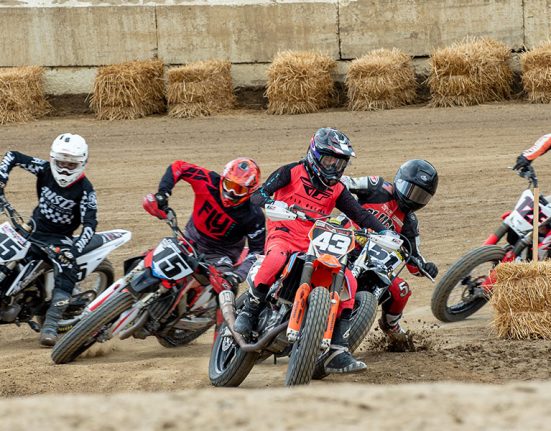The AMA’s intrepid On-Highway Government Affairs Manager gets schooled on the finer points of front brake and cornering technique
May 5, 2022
By Tiffany Cipoletti
NOTE: This article first appeared in the August 2021 issue of American Motorcyclist.
Hi. My name is Tiffany Cipoletti and, until last week, I was a true-blue Never Front Braker. OK, maybe not a never front braker, but let’s just say I was not confident using it, and it was probably the last thing I’d think of in an emergency situation. Not good, I know.
But all that changed recently for me and my trusty 2004 Harley-Davidson Sportster when I took the Yamaha Champions Riding School’s ChampStreet course headed by founder Nick Ienatsch and his team at New Jersey Motorsports Park. I’m pretty sure I learned skills there that could likely save my life one day. Plenty good, right?
Like many of you, I’m not much of a risk taker on the bike, mostly because I’m reasonably aware of my limits and realize things can go badly if you aren’t on top of things. Am I typically pulling up the rear on group rides? You betcha. It’s all a part of my calculated risk taking, and knowing exactly the distance I need to stop my motorcycle.
When I began riding six years ago I was reminded by more seasoned riders that there are two types of riders: those that have been down and those that will go down. And of course it wasn’t long — just six months — before I ended up in the latter group thanks to my less-than-capable front-braking technique. I wasn’t hurt badly, but I was lucky.
I was therefore excited to take the ChampStreet course, so let’s dive right into the curriculum, which takes many of the same track-riding techniques taught in the school’s two-day ChampSchool and applies them to street riding. Basically, it’s a street rider’s chance to live out his or her MotoAmerica fantasy of being on a real racetrack without all the barriers; lessons are taught at highway speeds on your street motorcycle in your street gear, and no leathers required.
We spent the morning with the coaches going over the basics of 100 points of grip; how properly loading the tire improves traction; trail braking; smooth braking and throttle application; learning how to effectively tighten and decrease your radius while corning; and emergency braking.
The first takeaway I had from the coaching, demonstrations and on-range exercises is how hard I was making cornering by not properly loading my front end before leaning my bike. The second was how radius equals MPH, which means I could potentially eliminate lean-angle risks by being consistent with neutral throttle and accelerating when I could see my exit.
All this conflicted with the “skills” I’d used previously, which, for cornering, was rolling off the throttle and coming into a corner at a turtle’s pace, and using my 130-pound body to lean my almost 600-pound motorcycle over — and hoping for the best. I knew of the general ideas of using throttle position to affect lean angle and “trail braking,” which means braking as you lean your bike into the corner. But my low-risk mentality kept me from ever actually doing them — especially on unfamiliar roads.

Lucky for me, I had a chance to put these skills to the test on track without fear of the dangerous interactions of real street-riding conditions. I work in motorcycle advocacy, and I know what the statistics say…that we motorcyclists are taking ourselves out at an alarming rate for failing to navigate a curve. According to the National Highway Traffic Safety Administration, more than half of motorcycle fatalities are single-vehicle accidents, and motorcycles are more frequently involved in fatal collisions with fixed objects than any other vehicle type.
How, I asked myself, was I going to convince my brain to keep up a modicum of speed approaching a corner, or start applying pressure on the front brake to begin to lean in? The cursed front brake had cruelly taught me a lesson when abruptly grabbing it in my early-career crash, so none of this seemed natural to me.
Riding with the Champ School instructors helped — a lot. On lap number one I nervously followed my instructor, watching his brake light intently to see where he was starting to brake, what line he was on, his neutral throttle speed and at what point he started to accelerate from the apex and stand his bike up.
In the next corner I told myself I was going to try it while repeating a phrase from coach Nick that you have to “load the tire before you work the tire.” But as soon as I saw the instructor’s brake light I chickened out, rolled off, and bumbled my way through the corner virtually upright. At one of the coaching stops I pulled over and watched someone run through the techniques one more time, and tried to convince my brain that we could do this.
“What’s the worst that’s going to happen today?” I asked myself. “That I might actually learn how to ride my motorcycle properly?” And off I went, following the coach again, but this time telling my brain we’d keep our speed up and carry a bit more momentum. And it worked! I studied the coach in front of me, watched where his light illuminated and held my throttle to that point, and then gently squeezed the lever. The first time wasn’t perfect, but nothing bad happened, and we did it again and again, and things got better and better until I was doing it without even thinking about it. Call it an epiphany of sorts.
By the time lunch rolled around I realized that my front brake was no longer the devil, and I began feeling like I wanted to go faster, which is something I never, ever wanted to do before. In the space of just a few hours I’d gone full circle in my attitude about riding and riding a motorcycle the way it was designed to be ridden.

Going in, I had so many doubts that I was never going to be this type of rider, but something clicked and my fear went away. Motorcycling has always been thrilling and something that I have been passionate about, but this course opened me up to a whole new level, and by late afternoon I was already kicking around the idea that maybe one day I would return to YCRS to participate in a two-day track school.
I cannot say enough good things about Nick Ienatsch, Chris Peris, Keith Culver, Chip Spalding and the rest of the coaches that worked with our class that day. My only regret is that I did not have access to this type of intense and specific training earlier in my riding career, as I’m confident I learned critical skills that’ll keep me safer on the road for the long haul. I no longer have to live on a wing and a prayer.
As a motorcycling advocate I’ve made it a point that if I’m going to “talk the talk” I need to “walk the walk” about rider training — and I have tried to fulfill that mission, taking six rider-training courses during my six years of riding. What I’ve learned above and beyond all the skills the various coaches have taught me, though, is that rider training should be an ongoing and continuing education.
Keep it shiny side up, and I hope to catch you all out there on the road one day soon.






